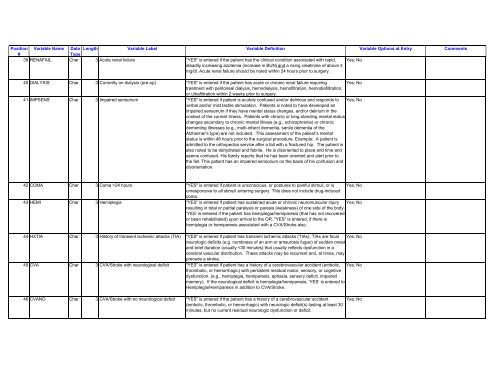User Guide for the Participant Use Data File - ACS NSQIP
User Guide for the Participant Use Data File - ACS NSQIP
User Guide for the Participant Use Data File - ACS NSQIP
You also want an ePaper? Increase the reach of your titles
YUMPU automatically turns print PDFs into web optimized ePapers that Google loves.
Position Variable Name <strong>Data</strong> Length Variable Label Variable Definition Variable Options at Entry Comments<br />
#<br />
Type<br />
39 RENAFAIL Char 3 Acute renal failure "YES" is entered if <strong>the</strong> patient has <strong>the</strong> clinical condition associated with rapid,<br />
steadily increasing azotemia (increase in BUN) and a rising creatinine of above 3<br />
mg/dl. Acute renal failure should be noted within 24 hours prior to surgery.<br />
Yes; No<br />
40 DIALYSIS Char 3 Currently on dialysis (pre-op) "YES" is entered if <strong>the</strong> patient has acute or chronic renal failure requiring<br />
treatment with peritoneal dialysis, hemodialysis, hemofiltration, hemodiafiltration,<br />
or ultrafiltration within 2 weeks prior to surgery.<br />
Yes; No<br />
41 IMPSENS Char 3 Impaired sensorium "YES" is entered if patient is acutely confused and/or delirious and responds to<br />
verbal and/or mild tactile stimulation. Patients is noted to have developed an<br />
impaired sensorium if <strong>the</strong>y have mental status changes, and/or delirium in <strong>the</strong><br />
context of <strong>the</strong> current illness. Patients with chronic or long-standing mental status<br />
changes secondary to chronic mental illness (e.g., schizophrenia) or chronic<br />
dementing illnesses (e.g., multi-infarct dementia, senile dementia of <strong>the</strong><br />
Alzheimer's type) are not included. This assessment of <strong>the</strong> patient’s mental<br />
status is within 48 hours prior to <strong>the</strong> surgical procedure. Example: A patient is<br />
admitted to <strong>the</strong> orthopedics service after a fall with a fractured hip. The patient is<br />
also noted to be dehydrated and febrile. He is disoriented to place and time and<br />
seems confused. His family reports that he has been oriented and alert prior to<br />
<strong>the</strong> fall. This patient has an impaired sensorium on <strong>the</strong> basis of his confusion and<br />
disorientation.<br />
Yes; No<br />
42 COMA Char 3 Coma >24 hours "YES" is entered if patient is unconscious, or postures to painful stimuli, or is<br />
unresponsive to all stimuli entering surgery. This does not include drug-induced<br />
coma.<br />
Yes; No<br />
43 HEMI Char 3 Hemiplegia "YES" is entered if patient has sustained acute or chronic neuromuscular injury<br />
resulting in total or partial paralysis or paresis (weakness) of one side of <strong>the</strong> body.<br />
‘YES’ is entered if <strong>the</strong> patient has hemiplegia/hemiparesis (that has not recovered<br />
or been rehabilitated) upon arrival to <strong>the</strong> OR. "YES" is entered, if <strong>the</strong>re is<br />
hemiplegia or hemiparesis associated with a CVA/Stroke also.<br />
Yes; No<br />
44 HXTIA Char 3 History of transient ischemic attacks (TIA) "YES" is entered if patient has transient ischemic attacks (TIAs). TIAs are focal Yes; No<br />
neurologic deficits (e.g. numbness of an arm or amaurosis fugax) of sudden onset<br />
and brief duration (usually


